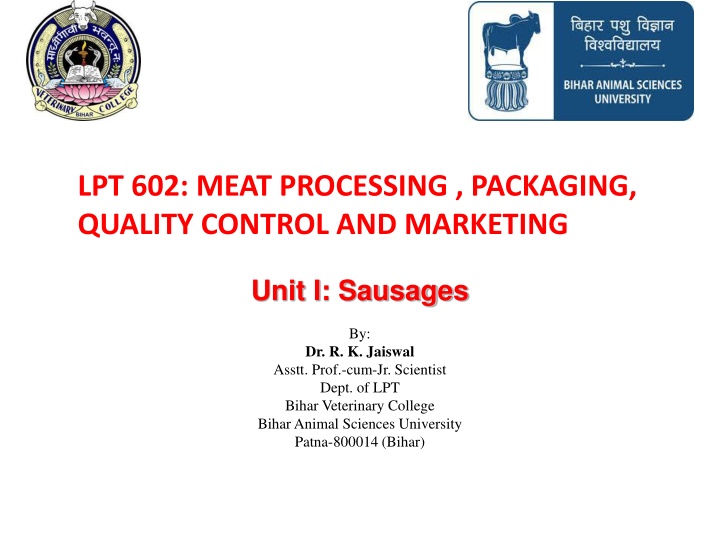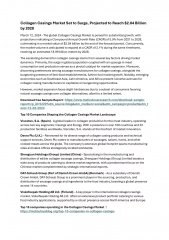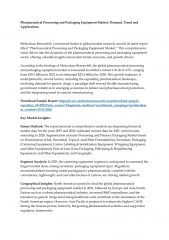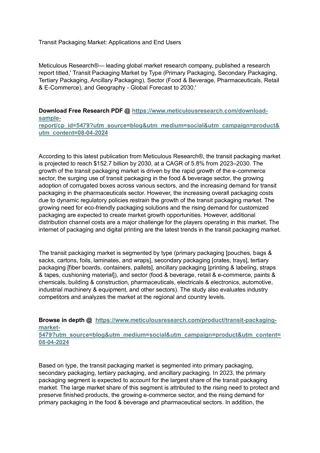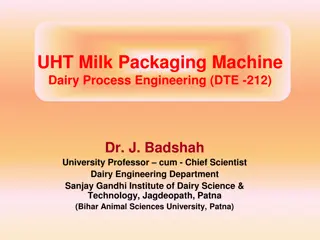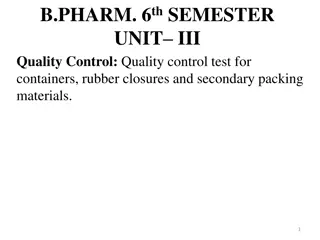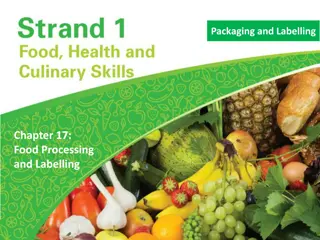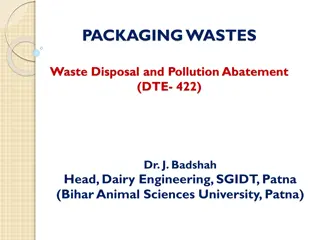Exploring the World of Sausages: Processing, Packaging, Quality Control, and Marketing
Delve into the fascinating history, classification, and consumer acceptance of sausages in this detailed study by Dr. R. K. Jaiswal. Learn about the various types of sausages based on chopping, cooking, smoking, water content, curing, and fermentation. Discover the characteristics and examples of fresh, dry, semidry, cooked, smoked, and specialty sausages. Gain insights into consumer preferences and the factors influencing their choice to consume sausages today.
Download Presentation

Please find below an Image/Link to download the presentation.
The content on the website is provided AS IS for your information and personal use only. It may not be sold, licensed, or shared on other websites without obtaining consent from the author.If you encounter any issues during the download, it is possible that the publisher has removed the file from their server.
You are allowed to download the files provided on this website for personal or commercial use, subject to the condition that they are used lawfully. All files are the property of their respective owners.
The content on the website is provided AS IS for your information and personal use only. It may not be sold, licensed, or shared on other websites without obtaining consent from the author.
E N D
Presentation Transcript
LPT 602: MEAT PROCESSING , PACKAGING, QUALITY CONTROL AND MARKETING Unit I: Sausages By: Dr. R. K. Jaiswal Asstt. Prof.-cum-Jr. Scientist Dept. of LPT Bihar Veterinary College Bihar Animal Sciences University Patna-800014 (Bihar)
Sausages The term sausage is derived from the Latin word "salsus" meaning salt, or, literally translated, refers to chopped or minced meat preserved by salting. Sausages are one of the oldest forms of processed foods, their origin being lost in antiquity. It has been reported that sausages were used by the Babylonians and the Chinese about 1500 B.C., although documented proof for this is lacking. There are, however, a number of well-documented references to the use of sausages during the eighth century B.C., the most notable of which is Homer's Odyssey.
Consumer Acceptance Consumers today eat sausages because of (1)Convenience (2)Variety (3)Economy (4)Nutritional value
Classification of Sausages 1. Degree of chopping a. Coarsely ground b. Emulsion or finely chopped 2. Amount of cooking a. Uncooked b. Cooked 3. Amount of smoking a. Un smoked b. Smoked: natural smoke; smoke flavorings, isolated smoke components
4. Amount of water added a. No added water b. Water added 5. Amount of curing a. Uncured (fresh) b. Cured 6. Amount of fermentation a. Unfermented b. Fermented
7. Amount of moisture in final product a. Fresh: un smoked or smoked b. Smoked: fresh and cured c. Cooked: fresh and cured-smoked and unsmoked d. Cured: smoked and unsmoked e. Meat loaves and specialty items f. Dried: semidry and dry
CLASSIFICATION CHARACTERISTICS EXAMPLES Fresh sausages Fresh meats (chiefly pork); uncured, comminuted, seasoned and usually stuffed into casings; must be cooked fully before serving Fresh pork sausage, Bratwurst Dry and semidry sausages Cured meats; fermented air-dried, may be smoked before drying; served cold. Genoa salami, Pepperoni, Lebanon bologna. Cooked sausages Cured or uncured meats; comminuted, seasoned, stuffed into casings, cooked and sometimes smoked; usually served cold. Liver sausage, Summer sausage,Braunschweige r, Liver cheese. Cooked, smoked sausages Cured meats; comminuted, seasoned, stuffed into casings, smoked and fully cooked; do not require further cooking, but some are heated for serving. Frankfurters, Bologna , Cotto salami. Uncooked, smoked sausages Fresh meats; cured or uncured, stuffed, smoked, but not cooked; must be fully cooked before serving. Smoked, country-style porksausage, Mettwurst, Kielbasa. Cooked meat specialties Specially prepared meat products; cured or uncured meats, cooked but rarely smoked, often made in loaves, but generally sold in sliced, packaged form; usually served cold. Loaves, Head cheese, Scrapple
Sausage ingredients Raw materials Excellent sausages can be made from various fresh trimmings and cuts that might ordinarily be underutilised. Materials such as cheek, jowl, head meat, pork fat and trimmings, which are seldom used freshly, make palatable sausages and are as good for this purpose as are any other cuts of meat. Other cuts from low quality carcasses may also be used. Only clean fresh or cured meats free from bones, tendons, and joints should be used. The skin should be removed from the pork. Meat by-products such as heart, liver, kidney, tongue and tripe obtained from beef, calves, sheep and hogs are used in many sausages.
Water Water is the most important non-meat ingredient and it should be permitted up to 3% for fresh sausages, luncheon meats and meat loaves. The final cooked sausage product should not exceed four times the protein content plus 10%. Protein During preparation of sausage batters or emulsion, meat proteins serve two functions: To encapsulate or emulsify fat, and To bind water.
If either of these is not accomplished properly, the sausage will be unstable and subject to breakdown during cooking. The fraction of muscle that contains salt-soluble myofibrillar (contractile) proteins is more important than the sarcoplasmic fraction, which contains water-soluble proteins. Approximately 55% of total muscle protein is myofibrillar, composed largely of myosin and actin. During the onset of rigor, myosin and actin are complexed to form actomyosin. The dissociated proteins are more extractable and have a greater ability to swell and bind water.
After the onset of rigor the swelling and extractability are influenced mainly by temperature and ultimate pH. The presence of excessive collagen in most sausage is undesirable and it is usually desirable for finished sausages to have no more than 25% of the total protein as collagen. Fat Fat contributes greatly to palatability of sausages, but it is also the source of many processing problems. Tenderness and juiciness of cooked sausages are affected by their fat content. Fat is added to emulsions or batters primarily through inclusion of beef and pork trimmings in formulations.
Since the pork fats are softer and melt at lower temperatures, they are easier to comminute than beef fats. During comminution, beef fats require higher temperatures than pork fats. Cooked sausages such as frankfurters, bologna and similar comminuted sausage products are limited by U.S. government regulation to a maximum of 30% fat.
Non-meat ingredients Salt Salt is the most critical ingredient in sausage manufacturing. Without salt sausages cannot be made. Salt has 3 primary functions - preservation, flavour enhancement and protein extraction to create the product to bind. Most sausages have 2-3 % of added salt. Sugar A variety of sugars are commonly used ranging from sucrose (cane or beet sugar C12H22O11) to dextrose (corn sugar C6H12O6), corn syrup, corn syrup solids, sorbitol are also used in later group.
Sugars are used mostly as flavouring agents to counteract the salt flavour intensity and to provide food for microbial fermentation in fermented sausages. Most sugars, except sorbitol increase the browning of meat during cooking. Dextrose is usually added at the 0.5 to 1 per cent level (of the meat weight) for fermented sausages. Spices and flavourings Spices are dried aromatic vegetable substances. The term may be applied to all dried plant products, which include herbs, aromatic seeds and dehydrated vegetables.
Spices are liable to certain variations in flavour, strength and quality. Allspice, ginger, nutmeg and pepper are products of tropical plants. They may represent the root, bark, bud, flower or fruit. Spices are used either whole or in one of the following processed forms: (1) ground, (2) essential oils, or (3) oleoresins. The latter two must be classified as flavourings. Most spices are used in processed form. Whole peppercorns used in certain dry sausages are an example of a whole spice.
Flavourings are spice extractives: essential oils or oleoresins. Extractives have the advantages of elimination of colour specks, freedom from bacteria, reduced shipping costs and less storage area. Herbs are leaves of plants grown in both temperate and tropical zones and are relatively low in total oil content while true spices are relatively high. Marjoram, sage and thyme are examples of herbs. Aromatic seeds are derived from plants cultivated in both temperate and tropical areas. Anise, coriander, dill and mustard are examples of aromatic seeds.
Vegetables are used in the dehydrated form. Examples are garlic and onions. Seasonings and flavourings are included in sausage emulsions or batters to add flavour to the product. Examples of seasonings and flavourings are Monosodium glutamate and nucleotides enhance flavour. Hydrolyzed plant proteins contribute a characteristic meaty flavour. Black pepper, cloves, ginger, mace, rosemary, sage and thyme possess antioxidant properties. Other flavour additives include smoke flavouring which is usually added as an oil or water solution of natural smoke and vinegar used in products like sulze or some pickled sausages. Both of these have definite bacteriostatic properties.
Extenders and binders These are called as nonmeat materials and also are less frequently referred to as fillers, emulsifiers or stabilizers. They are added to basic meat formulations for one or more of the following reasons: To improve emulsion stability To improve cooking yields To improve slicing characteristics To improve flavour, and To reduce formulation costs.
The use level is generally restricted to 3.5% with exception of soy protein isolate, which carries a 2% limit. Many extenders have an effect on colour, flavour and texture. Milk products are well accepted due to their positive flavour contribution. Nonfat dried milk, dried wheys, modified wheys and partially delactosed wheys are also available. Cereal extenders are mainly starch, bind water and impart a bland flavour. Soy proteins include grits or flour (50% protein), concentrate (79% protein) and isolate (90% protein). They may be available in a textured as well as a powder or ground form.
Soy isolate is a good binder, functioning much like meat protein in an emulsion or batter. Among other extenders are mustard flour and deheated ground mustard, which may be used at levels up to 1%. Yeast proteins represent another group of extenders as do milk protein hydrolysates. Many of these can be classified as flavourings. Gelatin, while not specifically an extender, is used as a binder for some loaf type products. Gelatin varies in gel strength and clarity according to Bloom number. Fillers such as starch, cereals and wheat flour and corn meal are used occasionally to lower the cost and the shrinkage and to bind to the product.
Nitrite and Nitrate Sodium nitrite (NaNO2) or potassium nitrite (KNO2) is added directly to sausage batter. Nitrite has four functions in cured meat and sausage products To develop the characteristic pink colour To provide bacteriostatic properties To improve the flavour To serve as a powerful antioxidant The bacteriostatic properties of nitrite are extremely important in the thermally processed, vacuum packaged products. Without nitrite the organism Cl.botulinum will jeopardize the safety of these products, the bacteria that causes botulism. Nitrite prevents the outgrowth of Cl.botulinum spores and subsequently the production of toxins. About 400 ppm of nitrite in the finished product is considered necessary for the formation of the cured colour.
Ascorbates and Erythrobates Ascorbates and Erythrobates are strong reducing agents that accelerate the conversion of metmyoglobin to myoglobin and nitric oxide. The vitamin ascorbic acid (C6H8O6) derivatives are also known as cure accelerators, since they hasten the curing reaction. The use level is 7/8 oz per 100 lb of meat (approximately 550 ppm). Antioxidants Antioxidants are added to the fresh and dry sausages to retard the development of oxidative rancidity. Oxidative rancidity develops in the unsaturated (double) carbon-carbon bonds in fatty acids present in meats. Salt, light, heating and freezing and traces of certain metals also increase oxidative rancidity. Grinding and chopping of meat for sausage production exposes more of the membrane fatty acids to oxidation. The most common antioxidant compounds used are BHA (Butylated hydroxy anisole), BHT (Butylated hydroxy toluene) and propyl gallate. They are added at 0.01 to 0.02% of fat content.
Phosphates Phosphates are added to improve the water binding capacity of meat and solubilize proteins and act as antioxidants and help protect and stabilize the flavour and colour of finished product. Through the use of phosphates, processors can attain a longer product shelf life and improve smokehouse yield. Phosphates are approved at a level not to exceed 0.5% in the finished product. The following phosphates are approved Di-sodium phosphate, Sodium metaphosphate, Monosodium phosphate, Sodium poly phosphate, Sodium triphosphste, Sodium pyrophosphate, Dipotassium phosphate and Potassium pyrophosphate.
Anti-microbial agents In general these are not permitted in sausage products. But they are allowed as a surface application on dry sausage to retard mold growth. A 3.5% solution of propyl paraben or a 2.5% solution of potassium sorbate may be used for this purpose. Usually these are applied as a drip. Monosodium glutamate (MSG) Monosodium glutamate is the sodium salt of glutamic acid, which is one of the common, naturally occurring, non essential amino acids found in protein. MSG brings out food tastes without contributing any noticeable odour or taste. Sodium lactate Sodium lactate is the sodium salt of lactic acid. It naturally occurs in animals and humans. Sodium lactate improves product stability and improves shelf life because of its bacteriostatic effect. It is a colourless syrupy liquid.
FORMULATION OF SAUSAGE Ratio of Lean meat to Offal Meat 7: 3 The other ingredients are to be added in terms of % wt of meat (i.e 2% means - 2% of the weight of meat added) Fat-10% Salt-2.5% Sodium or Potassium nitrite- 200 ppm Pyrophosphates -0.3% Spice mix -2% Condiments - 4% (3% onions and 1% garlic) Binder or extender - 10% Added water, preferably as crushed ice. - 10%
STEPS IN PROCESSING Mincing -It is advisable to cut the meat in small pieces, prior to mincing. -Fat is also minced in this Meat grinder with 1/8 plate and 5/8 plate are used for grinding the meat. Mixing This step may are may not be followed, but this increases uniformity. The cylinders of fat and lean obtained by grinding are tumbled in a mixer to give a uniform distribution of fat and lean particles. Mixing also aids in extracting and coating the fat and lean particles with salt soluble proteins.
Chopping A chopper is composed of a revolving metal bowl that contains the meat while the knife blades rotating on an axle cut through the revolving meat mass. The meat is first added followed by the salt, curing salts, phosphate and then the fat spice mix condiments and finally binder or filler is added and chopped together to produce a fine ground emulsion. The emulsion formed is not a true emulsion and is only a pseudo emulsion as fat and water are not in direct contact at all. Chopping results in extraction of muscle protein, especially myosin which serves as the dispersion matrix in which both fat and water of meat are dispersed on either side of the matrix.
Stuffing The sausage emulsion is also known as mix. Sausage dough or batter is transferred to stuffers for extruding into casings. At this point the size and shape of the product is determined. Natural casings (hog stomachs, beef bladders, or sheep intestines) or artificial casings (cellulose) may be used to package the meats. While making sausage one should be careful not to stuff the casings too tightly. Space is allowed for swelling during cooking otherwise, the casings may burst. There are three types of stuffing pumps. Piston type recommended for coarse-ground sausages and those having fat chunks. Screw type and Rotary type used for small sausages.
Linking and tying After the emulsion is stuffed into casings, the encased mass is tied with thread or fastened with metal clips. In case of small sausages such as frankfurters, stuffed casings are hoisted or drawn together to produce links either by hand or by mechanical devices. In linking sausage, the casings are pressed together at appropriate intervals and twisted around once. The direction of the twist is alternated, to allow the sausage to remain linked. One should be careful not to break artificial casings while linking, tying and knotting the links with string.
Smoking and cooking The sausages are placed on smoke trees or trolleys with 12 to 18 sticks per tree. The trees are transferred to the smoke house usually having an internal temperature of 15 to 20 C. During cooking the temperature rises to 68 to 72 C. The air velocity (4000 ft/min) in the smoke house influences the rate at which the sausages are cooked. Humidity of 35-45% is required to transfer smoke through cellulose casings into the product.
Chilling After smoking and cooking, the product is showered with cold water and then chilled by refrigeration. On large volume continuous operations, chilling is frequently done with a 6% brine solution by dipping or spraying. The brine permits lower chill temperatures and rapid cooling of the product. Peeling and packaging After properly chilling the product to an internal temperature of 1.5 to 4.5 C, the cellulose casings on frankfurters are removed. This is known as peeling. Peeling can be done by hand/machines. Peeled frankfurters can be packed with general information for sale to the consumers. Cleanliness cannot be overstressed in the making of sausage. Sanitation of ingredients as well as utensils is essential for best results. Sausage may be successfully stored in the freezer. These products tend to lose flavour during freezer storage. Therefore they should be used without long storage .
STEPS IN PRODUCTION OF THE EMULSION Lean meat highest in myofibrillar proteins is used for the formation of emulsion by mincing in a bowl chopper. Salt is added to about 4 to 4.5% of the lean meat and chopping is initiated by keeping the temperatures below 3 C (37 F). Commercially cold water or chopped ice is often added during processing to keep the meat from heating while being chopped. Chopping continues to a final temperature of 13 C (55 F) to 18 C (64 F). If the chopping is done in high temperature, the emulsion may break causing fat separation during the subsequent cooking step. In over chopping, fat particles are coated and the protein interface broken by further comminution. Once the emulsion is formed, the batter is at critical stage. Excessive physical handling, long holding times, etc., can reduce stability. The product should be stuffed into appropriate casing and moved to heat processing as soon as possible.
Frankfurters These are the most popular of all cooked and smoked sausages, representing 25% of all sausages sold. The meat formulation for frankfurters usually is 40-60% beef and 40-60% pork. Deviations from these limits are not uncommon where all meat by-products are used extensively or where all beef products are manufactured. Bull meat, boneless chucks plates, hearts and trimmings are the most commonly used beef ingredients. Pork trimmings containing various amounts of trimmable fat, and back fat and hearts compose the major port ingredients. Filler meats such as tongues, snouts, lips and other by-products may be used, but it is generally agreed that they should not exceed 20% of the meat formulation.
Salami These are fresh emulsion type of pork sausages. The batter is stuffed in broader casings, usually dried cattle oesophagus and hanged for 2 days at 4 C. It is smoked and cooked simultaneously in India. Thuringer This is a coarse ground, fermented, semi dry type sausage also known as Thuringer Summer Sausages. The pH of the sausage mix comes down to about 5.0 due to bacterial fermentation. Dextrose serves as a substrate for fermentation. Sausage mix prepared at 0 C is stuffed into casings and held in green or ripening room maintained at 25 C and 85-90% relative humidity until fermentation is complete (2-3days). These are smoked and cooked at 60-65 C. The moisture content of finished product is nearly 50%.
Dry sausages These are coarse ground, fermented sausages, e.g. Pepperoni. Sausage mix is stuffed into 40-44 mm animal casings and held for 9-11 days at 4 C. It is transferred to green room for 2 days to be maintained at 20 C and 70% relative humidity and then smoked for 3 days at 35 C and 80% relative humidity. The product is not cooked but held for 21 days in the drying room at 35 C and 70% relative humidity during which it will have shrinkage. The final product will have only 30-35% moisture content. Bologna It is an emulsion type sausage prepared from the meat of old animals. Hotdog It is a fairly spicy sausage in broader casings, usually weasand in India. Mortadella It is a dry sausage prepared in cattle bladder or artificial broader casings.
